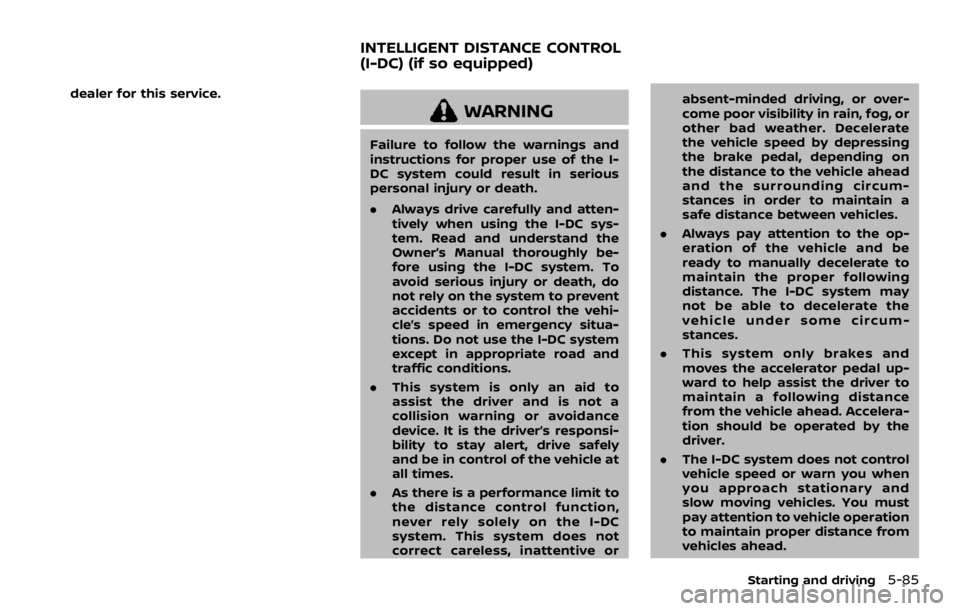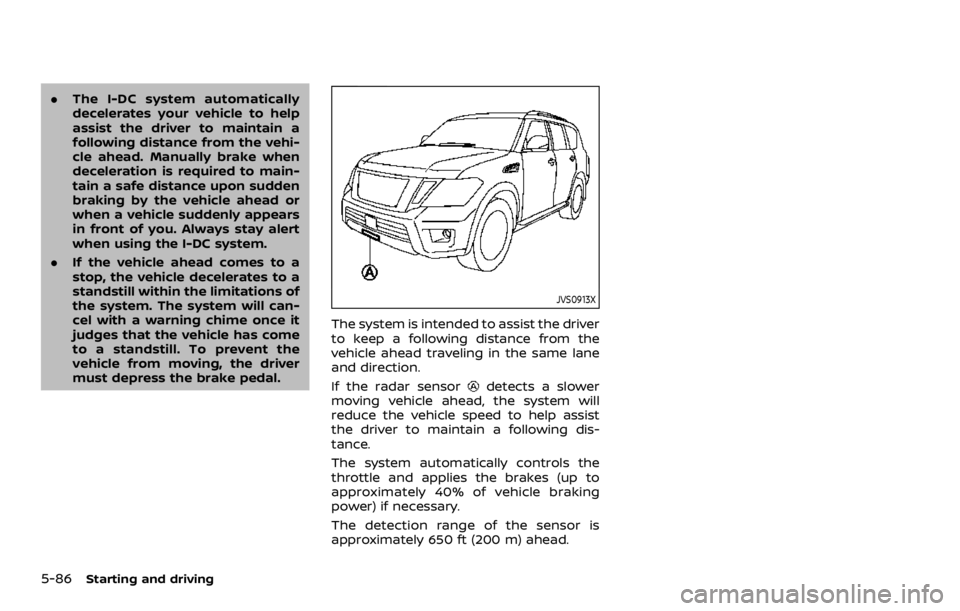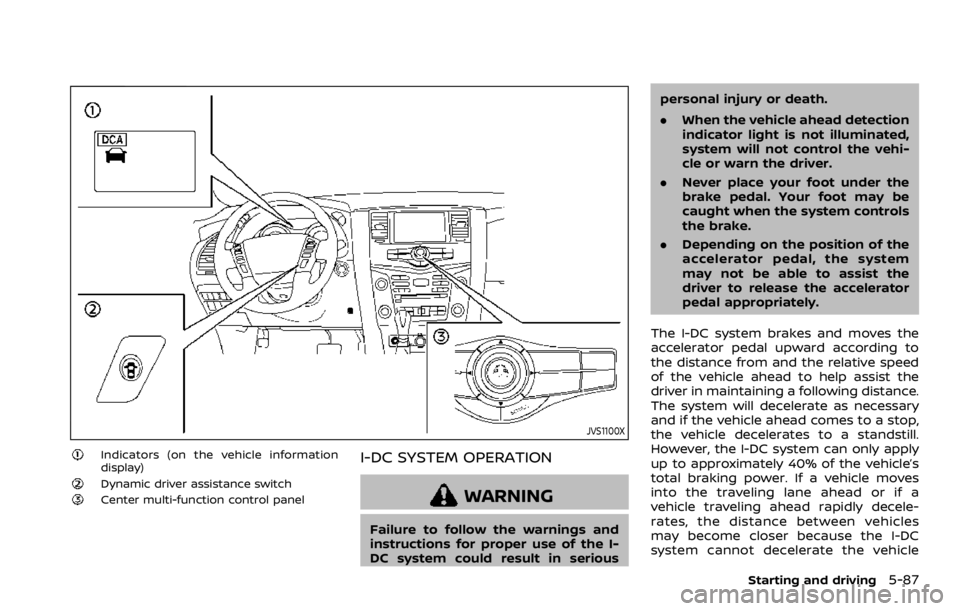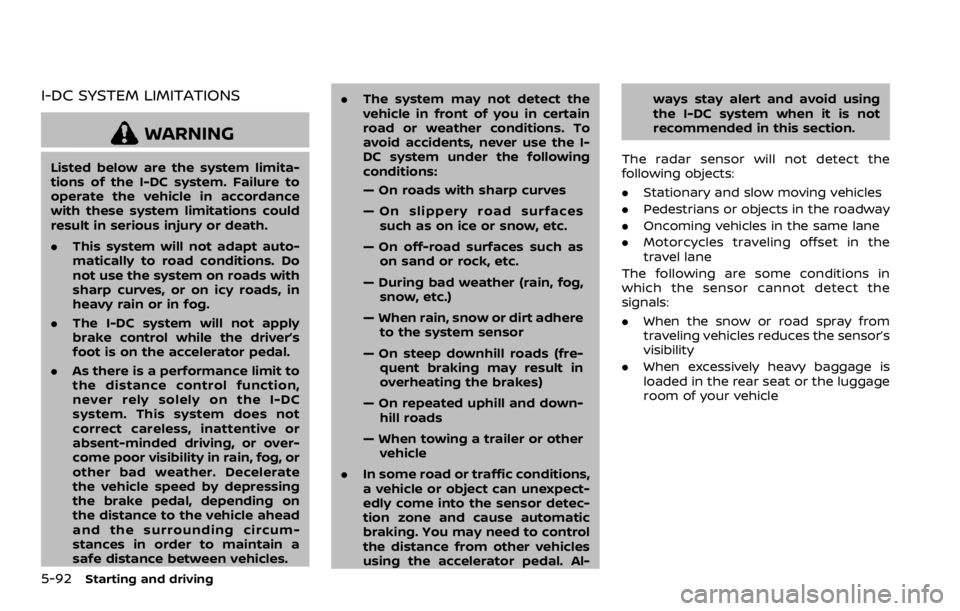NISSAN ARMADA 2020 Owner´s Manual
Manufacturer: NISSAN, Model Year: 2020, Model line: ARMADA, Model: NISSAN ARMADA 2020Pages: 528, PDF Size: 2.1 MB
Page 341 of 528

dealer for this service.
WARNING
Failure to follow the warnings and
instructions for proper use of the I-
DC system could result in serious
personal injury or death.
.Always drive carefully and atten-
tively when using the I-DC sys-
tem. Read and understand the
Owner’s Manual thoroughly be-
fore using the I-DC system. To
avoid serious injury or death, do
not rely on the system to prevent
accidents or to control the vehi-
cle’s speed in emergency situa-
tions. Do not use the I-DC system
except in appropriate road and
traffic conditions.
. This system is only an aid to
assist the driver and is not a
collision warning or avoidance
device. It is the driver’s responsi-
bility to stay alert, drive safely
and be in control of the vehicle at
all times.
. As there is a performance limit to
the distance control function,
never rely solely on the I-DC
system. This system does not
correct careless, inattentive or absent-minded driving, or over-
come poor visibility in rain, fog, or
other bad weather. Decelerate
the vehicle speed by depressing
the brake pedal, depending on
the distance to the vehicle ahead
and the surrounding circum-
stances in order to maintain a
safe distance between vehicles.
. Always pay attention to the op-
eration of the vehicle and be
ready to manually decelerate to
maintain the proper following
distance. The I-DC system may
not be able to decelerate the
vehicle under some circum-
stances.
. This system only brakes and
moves the accelerator pedal up-
ward to help assist the driver to
maintain a following distance
from the vehicle ahead. Accelera-
tion should be operated by the
driver.
. The I-DC system does not control
vehicle speed or warn you when
you approach stationary and
slow moving vehicles. You must
pay attention to vehicle operation
to maintain proper distance from
vehicles ahead.
Starting and driving5-85
INTELLIGENT DISTANCE CONTROL
(I-DC) (if so equipped)
Page 342 of 528

5-86Starting and driving
.The I-DC system automatically
decelerates your vehicle to help
assist the driver to maintain a
following distance from the vehi-
cle ahead. Manually brake when
deceleration is required to main-
tain a safe distance upon sudden
braking by the vehicle ahead or
when a vehicle suddenly appears
in front of you. Always stay alert
when using the I-DC system.
. If the vehicle ahead comes to a
stop, the vehicle decelerates to a
standstill within the limitations of
the system. The system will can-
cel with a warning chime once it
judges that the vehicle has come
to a standstill. To prevent the
vehicle from moving, the driver
must depress the brake pedal.
JVS0913X
The system is intended to assist the driver
to keep a following distance from the
vehicle ahead traveling in the same lane
and direction.
If the radar sensor
detects a slower
moving vehicle ahead, the system will
reduce the vehicle speed to help assist
the driver to maintain a following dis-
tance.
The system automatically controls the
throttle and applies the brakes (up to
approximately 40% of vehicle braking
power) if necessary.
The detection range of the sensor is
approximately 650 ft (200 m) ahead.
Page 343 of 528

JVS1100X
Indicators (on the vehicle information
display)
Dynamic driver assistance switchCenter multi-function control panel
I-DC SYSTEM OPERATION
WARNING
Failure to follow the warnings and
instructions for proper use of the I-
DC system could result in seriouspersonal injury or death.
.
When the vehicle ahead detection
indicator light is not illuminated,
system will not control the vehi-
cle or warn the driver.
. Never place your foot under the
brake pedal. Your foot may be
caught when the system controls
the brake.
. Depending on the position of the
accelerator pedal, the system
may not be able to assist the
driver to release the accelerator
pedal appropriately.
The I-DC system brakes and moves the
accelerator pedal upward according to
the distance from and the relative speed
of the vehicle ahead to help assist the
driver in maintaining a following distance.
The system will decelerate as necessary
and if the vehicle ahead comes to a stop,
the vehicle decelerates to a standstill.
However, the I-DC system can only apply
up to approximately 40% of the vehicle’s
total braking power. If a vehicle moves
into the traveling lane ahead or if a
vehicle traveling ahead rapidly decele-
rates, the distance between vehicles
may become closer because the I-DC
system cannot decelerate the vehicle
Starting and driving5-87
Page 344 of 528

5-88Starting and driving
quickly enough. If this occurs, the I-DC
system will sound a warning chime and
blink the system display to notify the
driver to take necessary action.
See “Approach warning” (P.5-89).
SSD0997
System set display with a vehicle aheadSystem set display without a vehicle
ahead
The I-DC system helps assist the driver to
keep a following distance to the vehicle
ahead by braking and moving the accel-
erator pedal upward in the normal driving
condition.
When a vehicle ahead is detected:
The vehicle ahead detection indicator
comes on.
When the vehicle approaches a vehicle
ahead:
.If the driver’s foot is not on the
accelerator pedal, the system acti-
vates the brakes to decelerate smoothly as necessary. If the vehicle
ahead comes to a stop, the vehicle
decelerates to a standstill within the
limitations of the system.
. If the driver’s foot is on the accelerator
pedal, the system moves the accel-
erator pedal upward to assist the
driver to release the accelerator pedal.
When brake operation by the driver is
required:
The system alerts the driver by a warning
chime and blinking the vehicle ahead
detection indicator. If the driver’s foot is
on the accelerator pedal after the warn-
ing, the system moves the accelerator
pedal upward to assist the driver to
Page 345 of 528

switch to the brake pedal.
NOTE:
.The stop lights of the vehicle come
on when braking is performed by
the I-DC system.
. When the brake operates, a noise
may be heard and/or vibration may
be felt. This is not a malfunction.
Overriding the system:
The following driver’s operation overrides
the system operation.
. When the driver depresses the accel-
erator pedal even further while the
system is moving the accelerator
pedal upward, the I-DC system control
of the accelerator pedal is canceled.
. When the driver’s foot is on the accel-
erator pedal, the brake control by the
system is not operated.
. When the driver’s foot is on the brake
pedal, neither the brake control nor
the alert by the system operates.
. When the Intelligent Cruise Control
(ICC) system is set, the I-DC system
will be inactive.Approach warning
If your vehicle comes closer to the vehicle
ahead due to rapid deceleration of that
vehicle or if another vehicle cuts in, the
system warns the driver with the chime
and I-DC system display. Decelerate by
depressing the brake pedal to maintain a
safe vehicle distance if:
.The chime sounds.
. The vehicle ahead detection indicator
blinks.
The warning chime may not sound in
some cases when there is a short dis-
tance between vehicles. Some examples
are:
. When the vehicles are traveling at the
same speed and the distance be-
tween vehicles is not changing
. When the vehicle ahead is traveling
faster and the distance between ve-
hicles is increasing
. When a vehicle cuts in near your
vehicle
The warning chime will not sound when
your vehicle approaches vehicles that are
parked or moving slowly.
NOTE:
The approach warning chime may
sound and the system display may
blink when the radar sensor detects
objects on the side of the vehicle or on the side of the road. This may cause the
I-DC system to decelerate or accelerate
the vehicle. The radar sensor may de-
tect these objects when the vehicle is
driven on winding roads, narrow roads,
hilly roads or when entering or exiting a
curve. In these cases you will have to
manually control the proper distance
ahead of your vehicle.
Also, the sensor sensitivity can be af-
fected by vehicle operation (steering
maneuver or driving position in the lane)
or traffic or vehicle condition (for example,
if a vehicle is being driven with some
damage).
Starting and driving5-89
Page 346 of 528

5-90Starting and driving
JVS1101X
I-DC system switch indicator (on the
vehicle information display)
Dynamic driver assistance switchCenter multi-function control panel
TURNING THE I-DC SYSTEM ON/OFF
To turn on the I-DC system, push the
dynamic driver assistance switchon
the steering wheel after starting the
engine. The I-DC system switch indicator
in the vehicle information display will
appear. Push the dynamic driver assis- tance switch
again to turn off the I-DC
system. The I-DC system switch indicator
will turn off.
The system will start to operate after the
vehicle speed is above approximately 3
MPH (5 km/h).
The dynamic driver assistance switch
is
used for the I-DC, I-LI (if so equipped) and
I-BSI (if so equipped) systems. When the
dynamic driver assistance switch
is
pushed, the I-LI and I-BSI systems will
also turn on or off simultaneously. The I-
DC system can be individually set to on or
off on the center display using the center
multi-function control panel
. If the
system is set to off, the system will not
turn on even if the dynamic driver assis-
tance switch
is pushed to on. To set the
system to on or off on the center display,
see “How to enable/disable the I-DC
system” (P.5-91).
When the conventional (fixed speed)
cruise control mode is operating, the I-
DC system will not operate. (To use the I-
DC system, turn the conventional (fixed
speed) cruise control mode off, then push
the dynamic driver assistance switch
.)
For details about the conventional (fixed
speed) cruise control mode, see “Intelli-
gent Cruise Control (ICC)” (P.5-63).
When the engine is turned off, the system
Page 347 of 528
![NISSAN ARMADA 2020 Owner´s Manual is automatically turned off.
JVS1043X
HOW TO ENABLE/DISABLE THE I-DC
SYSTEM
Perform the following steps to enable or
disable the I-DC system.
1. Push the SETTING button
.
2. Touch [Driver Assistance]. NISSAN ARMADA 2020 Owner´s Manual is automatically turned off.
JVS1043X
HOW TO ENABLE/DISABLE THE I-DC
SYSTEM
Perform the following steps to enable or
disable the I-DC system.
1. Push the SETTING button
.
2. Touch [Driver Assistance].](/img/5/40300/w960_40300-346.png)
is automatically turned off.
JVS1043X
HOW TO ENABLE/DISABLE THE I-DC
SYSTEM
Perform the following steps to enable or
disable the I-DC system.
1. Push the SETTING button
.
2. Touch [Driver Assistance].
3. Touch [Forward Assist].
4. Touch [Distance Control Assist] to turn the system ON/OFF.
SSD0994
I-DC SYSTEM DISPLAY AND INDICA-
TORS
The display is located between the speed-
ometer and tachometer.
1. I-DC system switch indicator:
Indicates that the dynamic driver
assistance switch is ON.
2. Vehicle ahead detection indicator:
Indicates whether it detects a vehicle
in front of you.
3. I-DC system warning light (orange): The light comes on if there is a
malfunction in the I-DC system.
Starting and driving5-91
Page 348 of 528

5-92Starting and driving
I-DC SYSTEM LIMITATIONS
WARNING
Listed below are the system limita-
tions of the I-DC system. Failure to
operate the vehicle in accordance
with these system limitations could
result in serious injury or death.
.This system will not adapt auto-
matically to road conditions. Do
not use the system on roads with
sharp curves, or on icy roads, in
heavy rain or in fog.
. The I-DC system will not apply
brake control while the driver’s
foot is on the accelerator pedal.
. As there is a performance limit to
the distance control function,
never rely solely on the I-DC
system. This system does not
correct careless, inattentive or
absent-minded driving, or over-
come poor visibility in rain, fog, or
other bad weather. Decelerate
the vehicle speed by depressing
the brake pedal, depending on
the distance to the vehicle ahead
and the surrounding circum-
stances in order to maintain a
safe distance between vehicles. .
The system may not detect the
vehicle in front of you in certain
road or weather conditions. To
avoid accidents, never use the I-
DC system under the following
conditions:
— On roads with sharp curves
— On slippery road surfaces
such as on ice or snow, etc.
— On off-road surfaces such as on sand or rock, etc.
— During bad weather (rain, fog, snow, etc.)
— When rain, snow or dirt adhere to the system sensor
— On steep downhill roads (fre- quent braking may result in
overheating the brakes)
— On repeated uphill and down- hill roads
— When towing a trailer or other vehicle
. In some road or traffic conditions,
a vehicle or object can unexpect-
edly come into the sensor detec-
tion zone and cause automatic
braking. You may need to control
the distance from other vehicles
using the accelerator pedal. Al- ways stay alert and avoid using
the I-DC system when it is not
recommended in this section.
The radar sensor will not detect the
following objects:
. Stationary and slow moving vehicles
. Pedestrians or objects in the roadway
. Oncoming vehicles in the same lane
. Motorcycles traveling offset in the
travel lane
The following are some conditions in
which the sensor cannot detect the
signals:
. When the snow or road spray from
traveling vehicles reduces the sensor’s
visibility
. When excessively heavy baggage is
loaded in the rear seat or the luggage
room of your vehicle
Page 349 of 528

SSD0252
The detection zone of the sensor is
limited. A vehicle ahead must be in the
detection zone for the system to operate.
A vehicle ahead may move outside of the
detection zone due to its position within
the same lane of travel. Motorcycles may
not be detected in the same lane ahead if
they are traveling offset from the center-
line of the lane. A vehicle that is entering
the lane ahead may not be detected until
the vehicle has completely moved into
the lane.If this occurs, the system may
warn you by blinking the system indi-
cator and sounding the chime. The
driver may have to manually control
the proper distance away from vehicle
traveling ahead.
Starting and driving5-93
Page 350 of 528

5-94Starting and driving
SSD0253
When driving on some roads, such as
winding, hilly, curved, narrow roads, or
roads which are under construction, the
sensor may detect vehicles in a different
lane, or may temporarily not detect a
vehicle traveling ahead. This may cause
the system to work inappropriately.
The detection of vehicles may also be
affected by vehicle operation (steering
maneuver or traveling position in the
lane, etc.) or vehicle condition.If this
occurs, the system may warn you by
blinking the system indicator and
sounding the chime unexpectedly. You
will have to manually control the proper
distance away from the vehicle travel-
ing ahead.